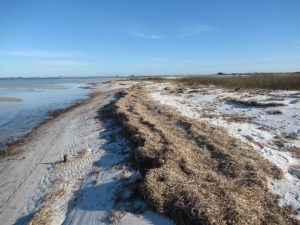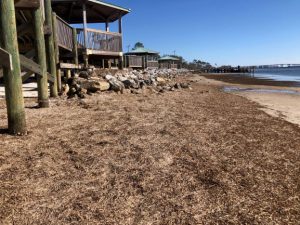
Besides a few vines near the foot of the sand dunes, the open beachfront where most visitors spend their time is essentially devoid of plant life. However, incoming waves will wash up and deposit dead plants, shells, algae, seeds, driftwood, and trash at the high tide line. This collection of material is called wrack. While it may look messy, the wrack line holds significant value to the ecosystem, and should not be removed (except for the trash, of course!). Wrack can collect drifting seeds and give them a protected area to take root, preventing shoreline erosion. The decaying material in wrack also provides nutrients and moisture to the soil, and a food source for insects and crabs.

Along Shoreline Park in Gulf Breeze, I recently encountered deep mats of dead seagrass (predominantly turtle grass) that washed up on the shore. Turtle grass is the most common seagrass found along the Florida coast. It has wide, green blades that grow in lush mats and can grow rapidly, as fast as one inch per week under ideal conditions. Once some of the grasses die back or break off, the winter tides expose the shallow beds and waves eventually push the dead blades to the beach. This natural process allows the plant material to break down and provide nutrients to the soil below, eventually serving as fertilizer for the next generation of plants.

Another frequently-encountered piece of wrack along the Gulf is sargassum. Sargassum is an algae characterized by its bushy, highly-branched stem with numerous leafy blades and berry-like, gas-filled structures that aid its buoyancy. It tends to accumulate into large mats that drift through the water in response to wind and currents These drifting sargassum mats create a pelagic habitat that attracts many marine animals. Many of these organisms are adapted to life within the sargassum, reaching full growth at miniature sizes and camouflaged in shape and color to blend in. The next time you see sargassum washed up, look closely—you many just see a tiny crab crawling around!
Some of the best shell collecting can be done along the wrack line, and I often observe sand dollars, driftwood, and exotic floating seeds. Sadly, plastic and other trash may end up in this area, too, so if you encounter it on a walk please help remove any non-natural debris to keep people and wildlife safe.
 1
1
